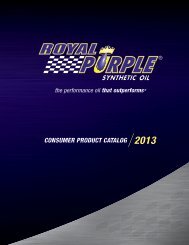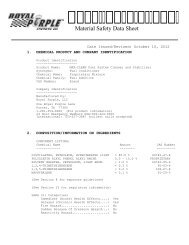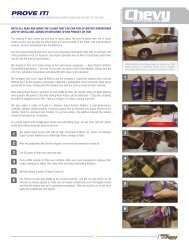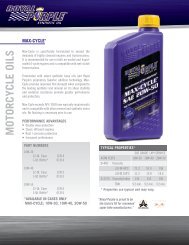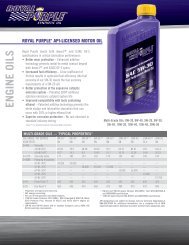500 lb-ft Small Block in Six Easy Steps - Royal Purple
500 lb-ft Small Block in Six Easy Steps - Royal Purple
500 lb-ft Small Block in Six Easy Steps - Royal Purple
Create successful ePaper yourself
Turn your PDF publications into a flip-book with our unique Google optimized e-Paper software.
Home<br />
•<br />
Why Use <strong>Royal</strong> <strong>Purple</strong><br />
•<br />
Videos<br />
•<br />
Consumer Products<br />
•<br />
Rac<strong>in</strong>g<br />
•<br />
Where to Buy<br />
•<br />
RP Apparel<br />
GO<br />
<strong>500</strong> LB-FT <strong>Small</strong> <strong>Block</strong> <strong>in</strong> <strong>Six</strong> <strong>Easy</strong> <strong>Steps</strong><br />
—courtesy, Hot Rod magaz<strong>in</strong>e<br />
This time it’s a quest for torque. Luckily,<br />
we got horsepower as a bonus. By the time we were done hang<strong>in</strong>’ a few speed parts off of a<br />
brand-new GM Performance Parts HT383 crate eng<strong>in</strong>e, it made <strong>500</strong> <strong>lb</strong>-<strong>ft</strong> at 4,200 rpm and 460 hp at<br />
5,400 rpm. That’s grunt<strong>in</strong>’ for a daily driveable 383.<br />
The HT383 has been available for a couple years now, but we’ve yet to see even one <strong>in</strong> a car, and we<br />
k<strong>in</strong>da wonder why. It’s probably because GMPP markets it as a “high-torque truck eng<strong>in</strong>e” with 325<br />
hp at 4,<strong>500</strong> rpm and 415 <strong>lb</strong>-<strong>ft</strong> of torque at 3,<strong>500</strong>. Most speed freaks will shun the truck connotation<br />
and guffaw at those power numbers, opt<strong>in</strong>g <strong>in</strong>stead for GM’s alum<strong>in</strong>um-headed Fast Burn 350 that
makes 385 / 385 for just an extra Frankl<strong>in</strong> over the HT383’s typical mail-order price. However, we’ll<br />
show you that an out-of-the-box HT383 is no slouch, and just a few well-chosen add-ons can make it<br />
scream. Best of all, you can add the stuff as your budget allows.<br />
But first, buy the eng<strong>in</strong>e. It’s PN 12497317, available for $3,895 from Scogg<strong>in</strong>-Dickey. The HT383<br />
comes as a complete long-block with all the t<strong>in</strong> plus a water pump and an alum<strong>in</strong>um dual-plane<br />
<strong>in</strong>take. It’s based on a brand-new production block with four-bolt ma<strong>in</strong>s and a one-piece rear-ma<strong>in</strong><br />
seal plus a set of the highly touted Vortec iron heads with 62cc chambers that mate with hypereutectic<br />
pistons (18cc dish, 0.026 <strong>in</strong> the hole) for 9.1:1 compression. The cam is a very t<strong>in</strong>y hydraulic roller<br />
with 196 / 207 duration at 0.050 with 0.431 / 0.451 li<strong>ft</strong>. The rods are powdered metal, but the crank is<br />
forged.<br />
Most curiously, the HT383 uses a slightly different combo than the pedestrian 383 kits. Whereas a<br />
typical stroker uses a 400-Chevy-type crank with 3.750 stroke <strong>in</strong> a 350-type block with 4.030 bore,<br />
the new GM crate eng<strong>in</strong>e has a standard bore of 4.000 <strong>in</strong>ches with a longer 3.800 stroke. The rods are<br />
5.7 <strong>in</strong>ches, which is stock for a 350. We <strong>in</strong>itially considered compar<strong>in</strong>g the 3.8-<strong>in</strong>ch-stroke HT383 to<br />
an otherwise identical 3.750-stroke 383, but decided the 0.050 additional stroke length just wouldn't<br />
make that big of a difference <strong>in</strong> torque. We may be wrong, as our tuned-up crate eng<strong>in</strong>e made more<br />
average torque than our dyno guys had ever seen from a low-compression 383. Read on to learn how.<br />
Step One: Get It Runn<strong>in</strong>g<br />
Your new HT383 will come out of the box complete with valve covers, a tim<strong>in</strong>g cover, an oil pan, an<br />
iron water pump, an 8-<strong>in</strong>ch harmonic balancer, an auto-trans flexplate, and a dipstick. You’ll need to<br />
provide a carb, ignition, and headers, which we did with components from Demon, Pertronix, and<br />
Hedman. We also opted to upgrade the stock oil pan with a Milodon claimer pan that has an <strong>in</strong>tegral<br />
w<strong>in</strong>dage tray, because we’ve found them to add a few horsepower. We were surprised to discover that<br />
the HT383 comes with both a partial w<strong>in</strong>dage tray and a full pan baffle, so <strong>in</strong> back-to-back tests, the<br />
Milodon unit didn’t help us out this time. With the tim<strong>in</strong>g set to 34 degrees (36 degrees produced the<br />
same power), the jets at 70 / 76, and an electric water pump <strong>in</strong> place, the HT383 overdelivered on the<br />
dyno, spitt<strong>in</strong>g out 338 hp at 4,400 rpm and 444 <strong>lb</strong>-<strong>ft</strong> at 3,400 rpm. That’s more than GM claims, with<br />
peaks 100 rpm lower than advertised. Perfect. Stab it <strong>in</strong> a big ol’ heavy 3,600-pounder-even with a<br />
mild TH350 and tame 3.00 rear gears-and we’d expect you to run <strong>in</strong> the mid 13s.
GM recommends a 750 carb for the<br />
HT383, but we’ve had such great luck with the little 625-cfm Road Demon that we used it for the<br />
<strong>in</strong>itial run-<strong>in</strong> and first few stages of test<strong>in</strong>g the eng<strong>in</strong>e.<br />
Right: We wanted to keep this eng<strong>in</strong>e simple, so our dyno ignition<br />
<strong>in</strong>cluded noth<strong>in</strong>g more than a Pertronix Flame-Thrower HEI. These all-new distributors <strong>in</strong>clude a coil<br />
and module specifically eng<strong>in</strong>eered to complement each other, plus a cap with brass term<strong>in</strong>als. We’ve<br />
found them among the best of the budget-priced HEIs. The wires are Pertronix Flame-Thrower 8mm<br />
dual-cores.<br />
Description Part Number Price<br />
GMPP HT383 crate eng<strong>in</strong>e 12497317 $3,895.00 at Scogg<strong>in</strong>-Dickey<br />
Hedman Tork-Step Hedders 68274 $199.95 (uncoated) at Summit<br />
Pertronix Flame-Thrower HEI D1000 $219.95
Speed Demon carb 4282010V $299.50 at Summit<br />
Milodon claimer pan 31503 $99.95 at Summit<br />
Milodon oil-pump drive 23050 $13.95 at Summit<br />
Milodon oil pump 18750 $40.39 at Summit<br />
Milodon pan baffle 32<strong>500</strong> $5.25 at Summit<br />
Power<br />
Peak HP 338.1 @ 4,400<br />
Peak Torque 444.3 @ 3.400<br />
Average HP 2,<strong>500</strong>-4,800 292.6S<br />
Average Torque 2,<strong>500</strong>-4,800 424.0<br />
Torque At 2,<strong>500</strong><br />
431 <strong>lb</strong>-<strong>ft</strong><br />
Above: We wanted torque, so we chose Hedman’s Tork-Step headers <strong>in</strong> an early Camaro design. The<br />
Tork-Step offer<strong>in</strong>gs propose to boost bottom end by us<strong>in</strong>g small, 1 ½-<strong>in</strong>ch tub<strong>in</strong>g for the first several<br />
<strong>in</strong>ches of each pipe, then stepp<strong>in</strong>g up to 1 5/8 tub<strong>in</strong>g. Once our 383 made horsepower <strong>in</strong> the mid-400s,<br />
we tried a swap to regular 1 5/8 headers and ended up ga<strong>in</strong><strong>in</strong>g a few horsepower while los<strong>in</strong>g a few<br />
<strong>lb</strong>-<strong>ft</strong> of torque. As a result, the Tork-<strong>Steps</strong> rema<strong>in</strong>ed on the eng<strong>in</strong>e for every dyno test <strong>in</strong> this story.
Above: While Milodon pans with w<strong>in</strong>dage trays have made proven power <strong>in</strong> our other tests, the<br />
HT383’s factory tray seemed to match its performance. We also used a Milodan high-pressure /<br />
high-volume pump-which boosted pressure by 20 psi at every rpm po<strong>in</strong>t as compared to the stock<br />
HT383 pump-and a Milodan hardened oil-pump drivesha<strong>ft</strong> and rear-pan baffle.<br />
page 1 2 3<br />
—courtesy, Hot Rod magaz<strong>in</strong>e<br />
top of page<br />
Why Use RP Why Use RP Articles Endors<strong>in</strong>g RP Independent<br />
Test<strong>in</strong>g Videos Unique<br />
Performance<br />
Advantages Which Oil is<br />
Right For You?<br />
FAQs Motor Oil FAQs Oil Filter FAQs Mar<strong>in</strong>e FAQs Motorcycle FAQs Rac<strong>in</strong>g FAQs 2-Cycle Eng<strong>in</strong>e<br />
FAQs Rotary Eng<strong>in</strong>e FAQs Transmission FAQs <strong>Purple</strong>-Ice FAQs<br />
Customer Comments<br />
“I am known by my friends to have a good ear when it comes to diagnos<strong>in</strong>g eng<strong>in</strong>e problems. I just<br />
got done chang<strong>in</strong>g the oil <strong>in</strong> my ’84 Bronco 351w and was gett<strong>in</strong>g ready to compare some numbers<br />
before and a<strong>ft</strong>er load<strong>in</strong>g <strong>in</strong> the <strong>Royal</strong> <strong>Purple</strong>. So I fired it up, and listened to it run for 30 seconds and<br />
shut it down. Oh my gawd! I am not even go<strong>in</strong>g to bother to compare the numbers. I could hear the<br />
change <strong>in</strong> rpm —this stuff is <strong>in</strong>credible!<br />
I cannot believe how a smooth runn<strong>in</strong>g eng<strong>in</strong>e can sound and run better, but m<strong>in</strong>e does a<strong>ft</strong>er <strong>Royal</strong>
<strong>Purple</strong>. Well, gotta go change the color of all my fluids to purple!”<br />
—Dave Madsen, customer<br />
Company History<br />
•<br />
About RP<br />
•<br />
FAQs<br />
•<br />
Sitemap<br />
•<br />
Industrial Division<br />
•<br />
Employment Opportunities<br />
•<br />
Contact Us<br />
•<br />
Privacy Policy<br />
Copyright ©2011. <strong>Royal</strong> <strong>Purple</strong>, Inc. All Rights Reserved.



